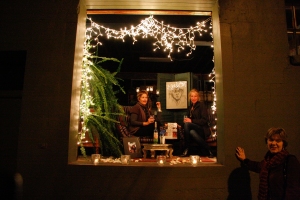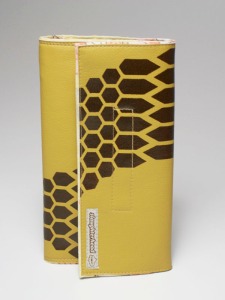This week: Jonathan Donehoo, designer, photographer, and Director of the School of Art at Louisiana Tech University. You can see Jonathan's work at 102: A Bistro at the solo exhibition "Magical Place Between", opening October 5th at 5pm.
This interview has been edited for length.
[wpvideo c3PgAkPf]
Do you think that the purpose of the photographs as a record of your experiences, and to reactivate your memory of them, do you think that comes through in the photographs?
It does to me. Because there's not a photograph I have that I can't say exactly where that is. I know the date. What it was like. I remember seeing that and going that was really neat. And you try to share that with others. But if they've not been there, it's just another chair. Just another tree. I guess that comes with traveling and experiencing things firsthand. When I was an undergraduate taking art history, and I'd sit in Renaissance history. It'd be cathedral this, and cathedral that. And they all looked the same. And then when I went there and started actually seeing them firsthand, they are not alike. Suddenly all of that made sense, you know. They were very distinct in their own way. But just looking at slide after slide of one baroque basilica after another, they all look the same. I guess it depends on your interests. It depends on that you've been able to experience it. That's why as a program we go to France in the spring with as many students as we can drag with us. And I think that experience firsthand is so important. And I think the faculty agree and put such a high value on travel, on the experience of travel and the education of travel. I wish we had deep pockets so we could just take everybody over there. Unfortunately we don't. But there's something about seeing it firsthand, experiencing it firsthand. It comes across in some of the pictures. But to me, the pictures mean lots of different things, but a little token of something that happened to me at one time is certainly part of that. As I said, I look at it and I know exactly what that was and what was going on. What was going on behind me, things like that. But that's my own personal worth in them. Other people looking at them certainly would not experience that because they weren't there. What they are taking away from the photograph may be something entirely different. I don't know.
It seems as if the subject matter of your photography is often architectural. Why do you think that is?
I think it has to do with space. Space and also the fact that I'm still very uncomfortable taking pictures of people I don't know. It seems like invading their privacy, and I should not be taking pictures of people. I'm not sure I like having my picture taken, especially by people I don't know. So I'm a little self-conscious about that. And you'll notice my pictures, very few of them have people in them. But I think architecture's a wonderful container for that light and dark that I'm interested in. You can do some out in nature, but architecture's just set up for that. An open door into a dark room and things like that. That little transition there. But I've always enjoyed architecture. And maybe it is the impossibility of photographing architecture in a real sense. Because architecture's three dimensional. It is an environment that you walk into. While a photograph is two dimensional, and you can look at as many pictures as you want to of something, but until you walk into that space, you don't really know what it's about. And I think the best example of that would be the Pantheon in Rome. Every art student has studied this. They've seen slides of it, in out around. But until you walk into that space for the first time and just feel that physical lifting that you get just by walking in there, it's just hard to describe that to anyone. So maybe it's just a vain attempt at capturing some little aspect of that.
While I was preparing for this interview, I was reading your artist statement and bio. I was interested in what you said earlier about the attention to detail in small neighborhoods in Paris. And also, I noticed that as a grad student, you taught beginning and advanced typography. I thought there might be a congruency there. Even when you think about the play with light and dark – light and shadow and you can compare that even to typography, the white and the black.
I love typography. I always have. I'd love to be better at it. And I don't know where the love of typography comes from. As an undergraduate at the University of Georgia, I had some renowned typographers as teachers. I don't know if they instilled that in me or not, but they helped me see that typography makes a difference. And it's about communication, and that's what type does. It's not about just the shape of a letter. It's how does this shape of a letter and all of the others combine to communicate an idea or a history or some story that people have. And I remember talking to freshman type students and saying typography in a way is like breathing. You use it everyday, you just don't think about it. When it's done correctly, you'll never notice. When it's done incorrectly, then you start noticing because you can't read it smoothly. I think it has a lot to do with communication, and that may come from the fact that I did not grow up in the United States. I was raised in other parts of the world. Communication and other languages was always, for me it was not a big struggle, but I know from my parents it always was. Because you had to learn a new language. So this whole idea of communication. Either visually through photographs. Or through type. Or story-telling, or anything else. All of this I think plays in that. How do you get your feelings, your ideas, your stories across.
It even seems as if there's an aspect to typography and even the languages, of maybe noticing things that other people don't notice.
That's just it. Even if you're here in Louisiana, and you've been here a lot of years, things that you become accustomed to, some people coming in from another part of the country, some are surprised or taken aback by something. I remember one time, we lived in a rather large city in South America. And it was not uncommon to have cattle grazing in the neighborhood. Or carts being pulled by Oxen, or something like that. Which, after a while you didn't notice at all. But when people would come to visit, they were just stunned to see cows eating in our front yard. And I remember hearing my father telling people who moved to these places for the first time, you need to take you pictures within the first six months. Because after that you won't even notice that this is unusual. I tell the young faculty that move here from out of state that they should take advantage of those first few years to really explore Louisiana. Go into Arcadiana and stuff, and just explore that because it is so unique. Later on, you just take it for granted. And that's a shame. But I guess that's human nature. You become accustomed to whatever it is around you, good or bad.
What's the payoff of noticing those things?
I think it adds a whole new depth to your existence. I would hate to live in just a white room with cheap paneling or something. I guess you get used to that. But it's in the details. It is there, and paying attention to it or just glossing over it. I guess everybody's interests would be in different details. I'm sure if an engineer came in and looked at something, the details they would notice would be different than the details I would notice. I guess it's up to you to do that. As teachers, what I think we try to do is make sure our students are aware that the details are there. Look at it. What are you seeing? I think that's what an artist is. We look at things. We see these things. And part of our job is to help others see these things. A musician hears things. We all hear things, but they hear things maybe we don't. And we see things maybe they don't.
Why did you move so much as a child?
My parents moved a lot.
For work?
Yes. My parents were foreign missionaries. So we went all over. And it was certainly a different way of growing up. Haha.
What were some of the most interesting places you lived?
Well I think everyplace is interesting. Even Ruston is interesting. But as far as being exotic or strange, I grew up in Columbia. I was in Costa Rica. All over.
Do you think your childhood, your immersion in missionary work and Christianity, do you think that's influenced your life as an artist in any way?
Probably not in the way people would hope. Haha. No, I think there's probably something in there. There's a part of my life that I consider to be very private. Maybe it was the way I was brought up. I'm somewhat suspicious of those that tend to wave things around a lot. I am suspicious of people who stand on the street corner and pound their chest and things like that. That's just not the way I was brought up. So I think my parents did instill in me certainly a sense of right and wrong, and a sense that especially as an American who has this comparatively great privilege in this world, that for real happiness, you have to somehow return some of that. It's not about more and more. It's about how do you help others get to a certain point. And I look at my siblings, and none of us went into the ministry, but I have one sister who's a teacher. I have one sister who's in medicine. And I have another brother who was in the military. But all of us in some way interpret what we do as giving back. I think we know there are certainly more lucrative jobs than higher education. But it's not about that. What effect do you have on other people's lives in a positive way? And maybe that's what you learn from being raised that way.
Obviously as director of the school of art you have a positive effect on people's lives. What are your thoughts about the effect your art might have on people's lives.
Well I hope I do a good job as an administrator. Maybe I just have a certain sickness for filling out forms. Haha. Because I do fill out a lot of paperwork that I don't think most people could stand. But it's just part of the job. And I hope what I do allows others, the teachers to spend more time working on what they do well. But as far as what I would like people to look at photographs, and first of all the people who have been able to travel. They see a picture of something and 'oh I remember things like that.' Bring back those hopefully pleasant memories. Those who have not had a chance to travel maybe go 'you know, maybe I need to go see that. I need to go out and look.' But I'm hoping they understand you don't have to go to Turkey to see this stuff. You can walk around Ruston and see this. You can walk around this building and see it. It's just a matter of looking at it in a certain light. A certain time of day. A certain way the wind is blowing. Just take advantage of that moment. But it doesn't have to be just exotic places. It can be right around you. Everyday life. I walk around the backyard and see things. You hope to just get people to start thinking in a visual sort of way, a creative way. What's different about that.
I think you're probably at this point the person in the art department that students get to spend the least time with. I'd like to ask a few personal questions.
Sure. I would say I do hate that. I do miss being in the classroom. Of course, I started teaching when I was very young. I was as old as my students. I was twenty-three. I had five graduate students. They were all older than I was. That was strange. So I grew up with them. They were friends. I've been best man. I'm godfather to their kids. It's just great they still think of me that way. But as I get older, there is that gap, and as I became the director, there's just not enough time to have all the classes I used to. I'm doing all this other stuff. As a director, in a way, I also become the ambassador for the program. It's funny when I meet students and I don't know them but I know their grandparents, or their parents. But I try to be a good voice for the program in my own way. So I've evolved out of one thing and into another. But I do miss that relationship that a teacher has with their students. I get a little bit of it sometimes with student workers in the office, but I do miss it. I recognize a lot of names more than I do faces. What questions do you have?
Do you have any hobbies?
I like to cook. Well, I like to eat. Haha. And I figured out a long time ago that if I like to eat, I would have to learn how to cook. I enjoy baking bread. I'm now experimenting with making cheese, artisanal cheeses. It remains to be seen how that's doing. And I do enjoy traveling a lot. I like to see things I've never seen. I like to experience things I've never experienced. I like to read. Nothing too exotic, I don't think. I'm just pretty normal.
I think it might not be too much of a stretch to say you're an introverted person?
Oh yeah, that's not a stretch at all.
I was wondering how that affects working in such a social and communicative field.
I think it goes back to the way I was brought up. My father is very much like I am. We're very quiet. We're slow to get to know. But my mother was very outgoing. Very social. She came from a very social family in Georgia. The two of them made a great pair. Between the two of them they would lick the platter clean. But I grew up in a social environment. My parents, even though they were missionaries, did a lot of entertaining because of the nature of their work. So I knew what they did and didn't do. So even though I'm not terribly comfortable in those situations, I do know how to do it. And I can do it. And I can bang my way through it. Just what we're doing now is not comfortable. But I've done it before, and I will be doing more things like this in the near future that I'm still lying awake at night about. But it's just part of the job. It goes with the territory. As the director of the school, I speak for the school sometimes. And you just have to put yourself out there, and just overcome that. You do it once, you do it twice, and it gets a little easier. I don't know that it ever becomes comfortable. You hope you don't fumble the ball. I'm afraid of heights. It scares me to death. And my father always taught me when I was young you just have to face your fears. You go do it. So there's not much in Europe I have not been on top of. Once. Haha. I go up there, and I do it, and I get back down off of, you know, the bell tower in Florence. I remember climbing that thing. It was awful. But I did it. I have no desire to ever do it again. You name a building, and I have been on top of it. And it is amazing. I still am afraid of heights. But you face your fears. And life is full of fears. Heights. Public speaking. Taking chances. Whatever it is. And either you can let that control you, and you can just not do it, or you can just take a deep breath and jump out there. I read something, and I'm trying to figure out how to weave this into something to share with students. In times of great stress in a person's life, where the odds are just impossible, you just don't know what you're going to do, you can either turn around and hide, or you can spread your wings and fly like an eagle. It's up to you. You can say no I can't do it, or you can say I'm going to just jump off and try it. And you'd be surprised. You fall sometimes, but if you turn around you know you're not going to do it. Take a deep breath and jump. People have done it for thousands of years. So you just have to take a little faith in yourself and jump.
Let's conclude by talking a little more about your photography. Tell me about the technical aspects. Do you use digital or analog?
Both. Honestly though, the last couple years it's all been digital. I remember the first time in the dark room, you put that exposure paper in the developer, and you look at it in the red light. And it's like magic. All of a sudden it appears. And you're going 'that's amazing.' You just get hooked on that. There's something about that process of being in the dark room. And that magic that takes place. But nowadays, and it's good and bad, digital allows you to make changes and alterations in a photograph or an image that you could not do in a darkroom. You could not dodge and burn that well. I think one of the big differences too is, when I was doing just film, I would go someplace, I'd come back and I'd have fifteen rolls of film. And I'd develop it all and process it. But you knew that you had to carefully compose in the camera. You had to think about what you were doing. You had to get the right settings. And so in that sense, it was like a rifle shot, as opposed to now in digital, you go click click click about thirty times and hope that one of them turns out. It's a much more shotgun approach. I still love analog. I still love film. But the reality is you're doing digital now, that's just what you do. And there are things in digital, there's just no way you could do that in analog. And some of the pieces I may or may not put into this show are panoramic pictures, where I took seven or eight pictures and wove them together into one bigger picture. I don't know how you could do that in the darkroom, and not have it obvious what you were doing. It's like anything else. You have a nostalgia for the old, but you still appreciate whatever the new part is.
Most of your pictures are black and white, and some are color. Could you tell me about the reasons behind your decision?
Part of it goes back to my first photography class as an undergraduate. I remember my teacher saying 'if it's not working in black and white, odds are color's not going to help it.' You cannot use color as an excuse for a bad picture. So you think about it in black and white. And I guess that's what I did until I started doing a lot of digital work, it was all black and white. And even now I'm surprised how monochromatic my work is. You look at it, even though it may be brown, it's still brown and white. Haha. Sometimes, there's these magic times, like there's this one piece that has color in it because of the sunset that made the whole thing magical. But most of my work is in fact black and white. And I think in this particular show there's a few pieces in color but most of it's black and white. Again, if color's important, I'll put color in it. But most of the time, color's not really what it's about.
I think that's all the questions I have.
Ok. You know, I appreciate the opportunity to share this with you. I very very rarely talk about myself or my work, so this is pretty unique.
Yeah, I really enjoyed it.
Well I appreciate you doing it.
Thank you.



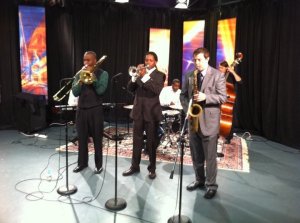



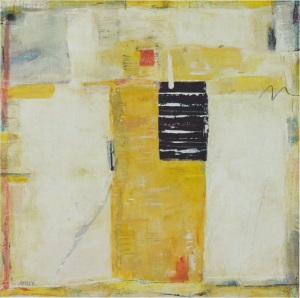


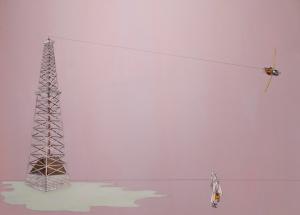
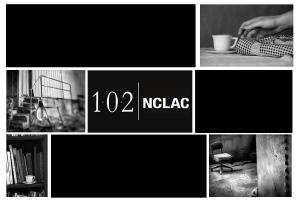
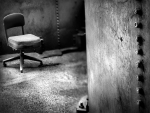
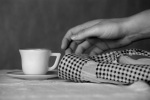
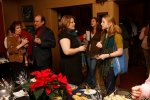



 The
The 


